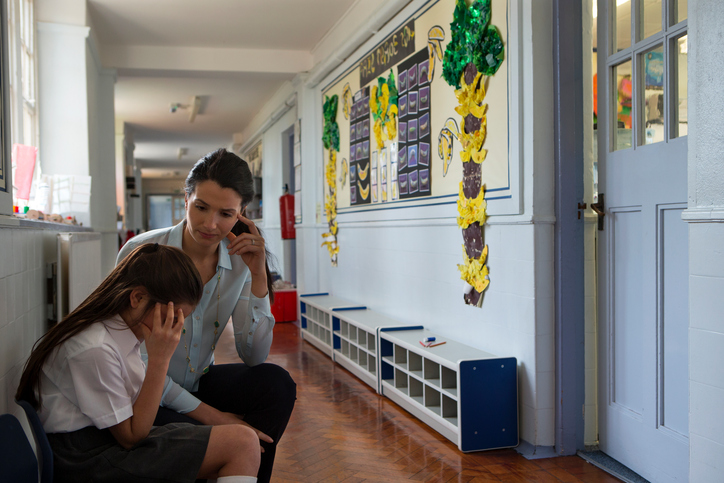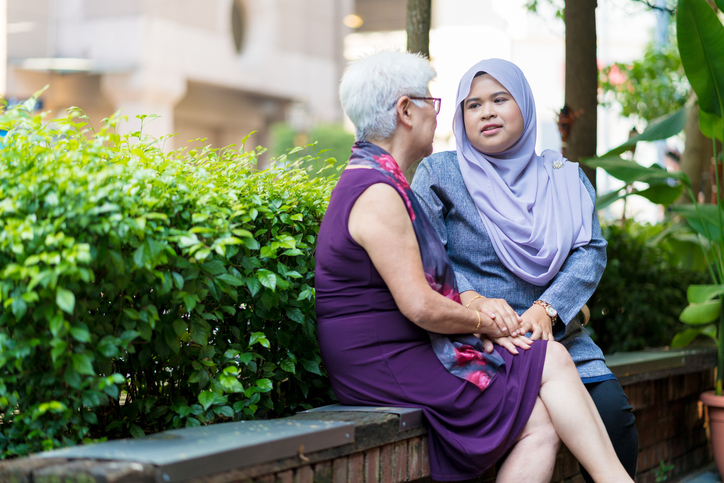 Abuse often occurs out of the public eye, so it can be difficult to recognize. Even when a person knows abuse is going on, they may not know how to help. This uncertainty can cause severe anxiety.
Abuse often occurs out of the public eye, so it can be difficult to recognize. Even when a person knows abuse is going on, they may not know how to help. This uncertainty can cause severe anxiety.
The best course of action can vary between contexts. When the victim is an independent adult, experts recommend following the person’s lead on which action to take. When the victim is a child or elder, an outsider may need to notify authorities. If a person suspects they are abusing others, they can support others by getting treatment for themselves.
If you suspect someone’s life is in imminent danger, you can call 911 for help.
- Offering Help to Adults Experiencing Abuse
- What is Mandated Reporting?
- How to Spot Abuse of Children
- Recognizing Abuse of Elderly or Disabled Adults
- How to Tell If You Are Abusive
Offering Help to Adults Experiencing Abuse
If you know someone who is experiencing abuse, you might feel helpless in observing their situation–especially if they have warned you taking any action may endanger them further. It can be heartbreaking to watch someone you care about continue to experience abuse. However, it is important for a victim of abuse to take action on their own time.
One of the most helpful things you can do for someone experiencing abuse is to listen and provide support without judgment. Reassure the person they are not at fault for the abuse they experience. Remind them help is available when they are ready.
You can also assist them in creating a safety plan. Whether they intend to notify authorities, leave a partner, or stay safer in the relationship, you can help them prepare. You might:
- Make sure they have contact information for a local or 24/7 helpline
- Help them practice an escape
- Do research on legal aid in their area
- Provide them with information on protection orders
- Take them shopping for essentials to pack in a getaway bag
- Encourage them to begin gathering evidence of the abuse, if they have not already
Only your loved one can determine when it feels safest and most appropriate to leave or seek other help. In the meantime, remember it is not your job to “rescue” them, give them advice about the abusive relationship, or intervene in any way.
What Is Mandated Reporting?
 Some individuals are obligated to notify authorities if they suspect a child is being abused or neglected. These people are called mandated reporters. Mandated reporting also applies to abuse of elderly adults and people with disabilities.
Some individuals are obligated to notify authorities if they suspect a child is being abused or neglected. These people are called mandated reporters. Mandated reporting also applies to abuse of elderly adults and people with disabilities.
Mandated reporters are often designated by their profession. Some professions, such as therapists, are typically bound to keep a person’s information confidential. Mandated reporting is an exception to this rule.
Laws related to mandated reporting vary by state. Most states list the following as people who are required to report abuse:
- Medical and mental health professionals
- Teachers and school administrators
- Social service, child care, or foster care workers
- Law enforcement and emergency response personnel
- Social workers, occupational therapists, and anyone who works with elderly or disabled individuals
Some states also require the following people to report:
- Members of the clergy or other individuals who work at religious institutions
- Employees or volunteers of any organization that provides activities for kids (camp counselors, coaches, etc.)
- Lawyers, mediators, guardians ad litem, and court-appointed special advocates
18 states and Puerto Rico include any adult who lives with a person under 18 as a mandated reporter.
All states encourage permissive reporting, meaning abuse reports that are not required by law. Any individual can report their suspicions if they believe another person is experiencing abuse or is in danger.
People who suspect abuse may notify a relevant organization such as child protective services. They can also get help from local law enforcement. Reporters do not need proof that any type of abuse is taking place to notify authorities. Assuming the report is in good faith, the reporter’s identity will remain secure. The reporter will not be liable for making the claim if it is not confirmed.
How to Spot Abuse of Children
Young kids may not realize their abuse is abnormal. An adult might convince an older child they deserve the treatment. Since many kids know their abusers, they can be reluctant to ask for help. A child is especially likely to stay silent about sexual abuse.
Yet even if a child does not talk about the abuse, they can still show symptoms. The following are common signs of child abuse, whether it be emotional, sexual, or physical:
- An unexplained fear of certain places of people
- Anxiety and clinginess
- Soiling clothes or wetting the bed past the appropriate age
- Nightmares or insomnia
- Overly sexual behavior
- Aggression toward animals and other children
- A lack of basic social skills
- Self-harm behaviors
None of these signs is proof of abuse. A child can live in a healthy environment and still have nightmares. Likewise, a child can be abused and not show any unusual behavior. But if a child shows many symptoms at once, or if their behavior shifts suddenly, there may be cause for concern.
If you think a child is being abused, you can call your state’s Child Protective Services to investigate. You can also call the Childhelp National Child Abuse Hotline at 1-800-4-A-CHILD (1-800-422-4453).
Recognizing Abuse of Elderly or Disabled Adults
 A vulnerable adult is a person over 18 who has difficulty caring for their own needs. This difficulty may be due to age or a disability. Vulnerable adults are at higher risk of experiencing abuse, neglect, and financial exploitation due to a relative inability to guard against harm.
A vulnerable adult is a person over 18 who has difficulty caring for their own needs. This difficulty may be due to age or a disability. Vulnerable adults are at higher risk of experiencing abuse, neglect, and financial exploitation due to a relative inability to guard against harm.
The number of elderly individuals in relation to the population at large is rising. Studies show instances of elder abuse, too, are increasing each year. Yet research suggests most cases of elder abuse go unreported. In 2011, the New York State Elder Abuse Prevalence Study found that for every case known to programs and agencies, 24 were unknown.
If you work with the elderly or have vulnerable loved ones, you can help by watching for red flags. Abuse or neglect might be occurring if the individual:
- Makes comments or hints that suggest they are experiencing abuse
- Is not getting basic needs met (food, water, adequate clothing, etc.)
- Is left unattended for long periods of time or when a caregiver should be present
- Lacks medical aids such as glasses, dentures, a walker, medication, or hearing aids
- Does not receive amenities or basic living essentials when a caregiver has control of their finances
- Exhibits changes in character or behavior that seems unlike them
- Withdraws abruptly on their own or because a caregiver is controlling their interactions with others
- Has bruises, scrapes, burns, or other marks that can’t be explained or related to a specific incident
- Has been a victim of forgery, fraud, theft, or other financial crime
Only you know what seems normal for the individual in question. If something seems questionable, it is important to notify an individual or agency who can take action on behalf of the vulnerable adult. There is no penalty for making a good faith report that is never confirmed.
Anyone providing services for elderly or disabled adults is a mandated reporter of abuse. Notification channels for reporting include local law enforcement, adult protective services, or residential care services.
How to Tell If You Are Abusive
No one wants to believe they are a perpetrator of abusive behavior. Yet for whatever reason–life circumstances, childhood experiences, or something else–a person might be driven to abusive acts.
If you worry that you are behaving abusively toward someone, ask yourself these questions:
- Do you get jealous or possessive when the individual spends time with anyone besides you?
- Do you monitor the other person without them knowing (By reading their email, checking their location via GPS, etc.)?
- Do you demand the person get permission before every activity or purchase?
- Do you often take your stress or anger out on the other person?
- Do you have to win every argument, no matter how small?
- Do you rely on threats, violence, or intimidation to get your way?
- Do you excuse any questionable actions on drugs or alcohol?
- Do you blame the other person for “making” you hurt them?
If you said ‘yes’ to most of these questions, you may want to take a hard look at your behavior. There is no excuse for abuse. In fact, excuses may be a sign that you know on some level your actions are wrong.
The emotions or mental health stressors that may be contributing to your conduct are valid. However, they don’t absolve you of responsibility. Circumstances can make abusive behavior more likely, but the ultimate cause of abuse is the person doing the behavior.
If you see any of these indications of abuse in your own life, help is available. Through therapy, you can learn healthier ways to express your feelings and cope with stress. In time, you can develop behaviors that do not cause harm to yourself or other people.
References:
- Blame shifting and minimizing: There’s no excuse for abuse. (2014, January 15). The National Domestic Violence Hotline. Retrieved from http://www.thehotline.org/2014/01/15/blame-shifting-and-minimizing-theres-no-excuse-for-abuse
- Caregiver abuse. (n.d.) Retrieved from http://www.nursinghomeabuseguide.org/elder-abuse/caregiver-abuse
- Frequently asked questions about mandated reporting. (n.d.) Darkness to Light. Retrieved from https://www.d2l.org/wp-content/uploads/2017/01/Mandated_Reporting_07.07.15.pdf
- Get help. (n.d.) National Adult Protective Services Association. Retrieved from http://www.napsa-now.org/get-help
- Help a friend or family member. (n.d.) The National Domestic Violence Hotline. Retrieved from http://www.thehotline.org/help/help-for-friends-and-family
- Help for abusive partners. (n.d.) The National Domestic Violence Hotline. Retrieved from http://www.thehotline.org/help/for-abusive-partners
- Mandatory reporters of child abuse and neglect. (2016). Child Welfare Information Gateway. Retrieved from https://www.childwelfare.gov/pubPDFs/manda.pdf#page=3&view=Standards%20for%20making%20a%20report
- Protection for mandated reporters. (2018). Pennsylvania Family Support Alliance. Retrieved from http://www.pa-fsa.org/Mandated-Reporters/Understanding-Mandated-Reporting/Protection-for-Mandated-Reporters
- Path to safety. (n.d.) The National Domestic Violence Hotline. Retrieved from http://www.thehotline.org/help/path-to-safety
- Peterson, K., & Vaughn, B. (2013, September 10). Vulnerable adult and elder abuse. Victims of Crime. Retrieved from http://victimsofcrime.org/docs/nat-conf-2013/vulnerable-adult-and-elder-abuse-presentation.pdf?sfvrsn=2
- Red flags of abuse. (n.d.) National Center on Elder Abuse. Retrieved from https://ncea.acl.gov/resources/docs/Red-Flags-Elder-Abuse-NCEA-2015.pdf
- Robinson, L., Saisan, J., & Segal, J. (2018). Elder abuse and neglect: Spotting the warning signs and getting help. Retrieved from https://www.helpguide.org/articles/abuse/elder-abuse-and-neglect.htm
- Statistics/data. (n.d.) National Center on Elder Abuse. Retrieved from https://ncea.acl.gov/whatwedo/research/statistics.html
- Teaster, P. (2000). A response to the abuse of vulnerable adults: The 2000 survey of state adult protective services. National Center on Elder Abuse. Retrieved from https://ncea.acl.gov/resources/docs/archive/2000-St-APS-Survey-Results-2003.pdf
- Thom, K. (2016, February 1.) 9 ways to be accountable when you’ve been abusive. Everyday Feminism. Retrieved from https://everydayfeminism.com/2016/02/be-accountable-when-abusive
- Tips for intervening if you witness domestic violence. (2017, May 30). The National Domestic Violence Hotline. Retrieved from http://www.thehotline.org/2017/05/30/intervening-domestic-violence
- What is abuse? (n.d.) National Adult Protective Services Association. Retrieved from http://www.napsa-now.org/get-informed/what-is-abuse

